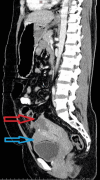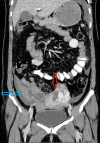A Rare Occurrence of Uterine Perforation Following the Dilation and Curettage for Missed Abortion
- PMID: 39449922
- PMCID: PMC11500271
- DOI: 10.7759/cureus.70079
A Rare Occurrence of Uterine Perforation Following the Dilation and Curettage for Missed Abortion
Abstract
Uterine perforation represents an uncommon yet potentially significant complication that may arise during the process of dilation and curettage (D&C), a frequently conducted procedure employed for a variety of gynaecological indications, including missed abortion. This report delineates an atypical case of uterine perforation in a 30-year-old female patient who underwent D&C subsequent to a missed abortion at 10 weeks of gestation and subsequently experienced acute abdominal discomfort accompanied by clinical features of internal haemorrhage shortly after the intervention. Diagnostic imaging corroborated the occurrence of uterine perforation, prompting the execution of emergency surgery to rectify the perforation and address concomitant complications. Following the surgical intervention, the patient achieved a complete recovery. This case report underscores the necessity for heightened vigilance during D&C procedures. The early identification and swift surgical management of this condition are imperative to avert severe morbidity or mortality associated with this infrequent complication. Furthermore, it accentuates the importance of pre-operative counselling and post-operative surveillance to ensure the timely identification and management of potential complications.
Keywords: abortion; d&c; dilatation and curettage; hemoperitoneum; uterine perforation.
Copyright © 2024, Dudhe et al.
Conflict of interest statement
Human subjects: Consent was obtained or waived by all participants in this study. Conflicts of interest: In compliance with the ICMJE uniform disclosure form, all authors declare the following: Payment/services info: All authors have declared that no financial support was received from any organization for the submitted work. Financial relationships: All authors have declared that they have no financial relationships at present or within the previous three years with any organizations that might have an interest in the submitted work. Other relationships: All authors have declared that there are no other relationships or activities that could appear to have influenced the submitted work.
Figures



Similar articles
-
Bleeding in the retroperitoneal space under the broad ligament as a result of uterine perforation after dilatation and curettage: Report of a case.J Obstet Gynaecol Res. 2017 Apr;43(4):779-782. doi: 10.1111/jog.13252. Epub 2017 Jan 21. J Obstet Gynaecol Res. 2017. PMID: 28109122
-
Uterine perforation and bowel incarceration following a second trimester abortion.Int J Surg Case Rep. 2025 Jun;131:111306. doi: 10.1016/j.ijscr.2025.111306. Epub 2025 Apr 14. Int J Surg Case Rep. 2025. PMID: 40273575 Free PMC article.
-
Omental incarceration secondary to uterine perforation after dilatation curettage: Conservative approach in sub-saharan Africa.Clin Case Rep. 2024 Oct 17;12(10):e9480. doi: 10.1002/ccr3.9480. eCollection 2024 Oct. Clin Case Rep. 2024. PMID: 39421526 Free PMC article.
-
Transvaginal strangulated bowel evisceration through uterine perforation due to unsafe abortion: a case report and literature review.BMC Womens Health. 2021 Mar 5;21(1):98. doi: 10.1186/s12905-021-01247-y. BMC Womens Health. 2021. PMID: 33663467 Free PMC article. Review.
-
Uterine Perforation as a Complication of the Intrauterine Procedures Causing Omentum Incarceration: A Review.Diagnostics (Basel). 2023 Jan 16;13(2):331. doi: 10.3390/diagnostics13020331. Diagnostics (Basel). 2023. PMID: 36673141 Free PMC article. Review.
References
-
- Uterine perforation during dilatation and curettage. Melvin RH, Korman W. https://pubmed.ncbi.nlm.nih.gov/13981418/ Obstet Gynecol. 1963;21:210–215. - PubMed
-
- Imaging evaluation of uterine perforation and rupture. Aboughalia H, Basavalingu D, Revzin MV, Sienas LE, Katz DS, Moshiri M. Abdom Radiol (NY) 2021;46:4946–4966. - PubMed
-
- Antepartum uterine rupture occurring at the site of a previously repaired dilatation and curettage-induced perforation: a case report. Ghahramani L, Moslemi S, Tahamtan M, Hashemizadeh MH, Keshavarzi A. https://pubmed.ncbi.nlm.nih.gov/27162833/ Bull Emerg Trauma. 2013;1:96–98. - PMC - PubMed
-
- Rupture uterus in primigravida: morbidity and mortality. Padhye SM. https://pubmed.ncbi.nlm.nih.gov/18604081/ Kathmandu Univ Med J (KUMJ) 2007;5:492–496. - PubMed
Publication types
LinkOut - more resources
Full Text Sources
